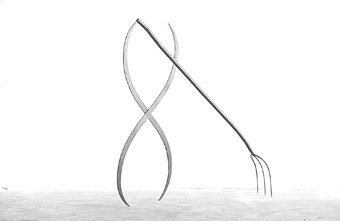The quiet archaeology of Neil Roberts
Zsuszanna Soboslay: The Collected Works of Neil Roberts

Neil Roberts, Things in the State of Belonging
collection, the artist, photo the artist
Neil Roberts, Things in the State of Belonging
If you soften your eyes, relax, let go of hard-edged purposes and intentions, you can look at objects differently—their textures, timbres, rhythms, how they have sat or walked in the world; not just their alliances and fights with each other; but also their gentler kinships, potentials, hopes to evolve.
There are forms of art which rely on the agon—a testing of object versus object, a gladiatorial match. And there are others which remember both the salt-taste of memory and the hopeful recombinant geometries underlying form. Although Neil Roberts’ work is largely sourced from objects-in-the-working-world (workgloves, cables, funnels, pizza trays), the weight of their uses becomes only a molecular part of their inherent qualities—and the cries for recombination that their edges yearn for.
Roberts in the studio: patient, peripherally scanning, hearing the cry of the object to mate differently, create a new creature, shift DNA.
So, when Roberts welds together a hoe and large caliper so that they lean into each other, strength resting in their paired fulcrum, teeth just touching the floor, they are both objects of labour (memory of sweat), and a black-bodied dance crossing air and time. Mantis and mantis coming to mate. Sweat and soil become proportional in a larger matrix which, like love, kisses into another space.
Take some umbrella frames—6 vacant hats, pincered pinnacles, girders for a seagull’s nest, perhaps; have them crouch atop 24 spidery long tubes of glass, messengers from the ground. Exquisite insects, aliens hovering; we stumble into a delicate world.
A long vein of old trowels hang along a wall, rusting diamonds embossed and flecked with fossils, millipede whorls, stones, glass fragments, a wallpaper rose, coiled wire like Rapunzel’s hair beginning to unfold. This series utters a quiet archaeology—echo of a building-site, childish trespass amongst grandfather’s toil, perhaps; but its thisness is stronger than sentimental memory: a tramline of tools, small meetings, shape within shape, what can a diamond hold. This is amplified by a roll-call of some 40 chalice-shaped petrol funnels along the parallel wall, their angular double-cupping echoing the negative space between those blades.
This sump-oiled Arthurian feast starts a reverb which connects to other objects in the room, most of which comment with soft inflection on men’s work/masculinity. The figures implicitly related to these objects are heroes, less so for their brawn or the violence of their strength, than the delicacy of the motion within their muscles, as the eye traces the necessary line of movement to a goal, and the arm and body fulfil their trajectories.
Roberts talks of “parallel universes…existing outside our perception, spending a blink of their existence in our known world.” This applies to actions both within and between people and objects, as well as to inherent qualities. At times, a nascent activity states itself (O2 drawn on a rusting tool). At others, the lines of energy between 2 boxers, or the swing of a punching-bag, becomes a drawing translated into leaded glass. Half Ether, Half Dew Mixed with Sweat wraps a carapace of Tiffany glass over a leather punching bag: fragile strength, harsh virility yoked in an embrace. “Go on, hit me,” they both seem to say. And how they might have moved, been moved, is also part of the piece: in its making, molten glass “flows slow”, as does the mind of the boxer punching sweet. Traditional church glass’s function was to “make visible the energy of God”; Half Ether’s leather, glass and lead literally hold each other’s lines of inspiration and flight. Their differences do not so much play out as dis/splay a new animal being formed.
Other works wrap wire, mesh or chain around cable, insulated wire, or bottles crushed by a goliath (a bikies’ night in). Baudelaire’s Rope (based on a short story about the rope used by a suicide which becomes an object of collectors’ desire) ponders how strangely a fetish-object is kept alive, the rope perhaps providing a link of relatedness that was missing in the suicide’s life; in this strange way, the suicide is held, perhaps for the first time. There is both astute social observation and a challenge to judgmentalism in this leaded posie whose cut lengths are only half-displayed. As with the head-banded cables of For Those Who Suffer Uncertainty there is a kind of sanctuary, a continuity of substance in the metallic embrace of something which has, or wants to, die, bequeathed to a livingness in the meeting of these wires.
Perhaps poignancy hits most in the blacksmithing aprons suspended from another wall: tired at day’s end, hung upside-down, the leather is patched with a splayed football opening like a flower. The aprons bare both gut and heart, hope and loss, an exquisite questing emanating from beneath the protective skins of work and toil.
The Collected Works of Neil Roberts, part of Metis 2001: Wasted, curated by Merryn Gates, Canberra School of Art Gallery, May 5-June 10
With thanks to Barbara Campbell for a transcript of Neil’s talk given for Artforum, Canberra School of Art, June 6.
RealTime issue #44 Aug-Sept 2001 pg. 39






